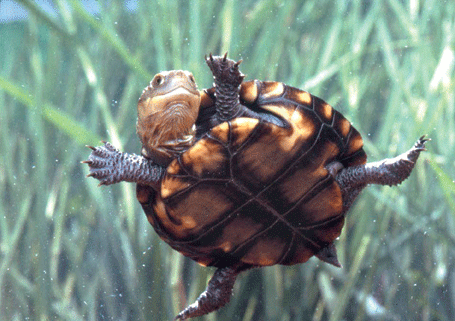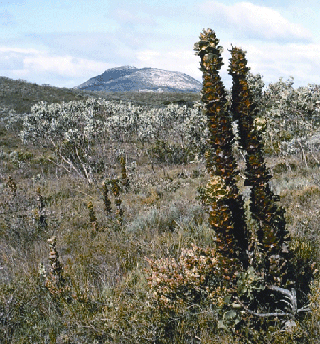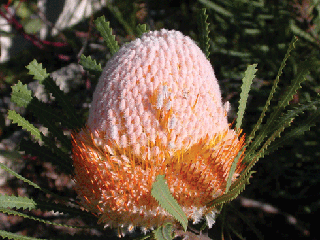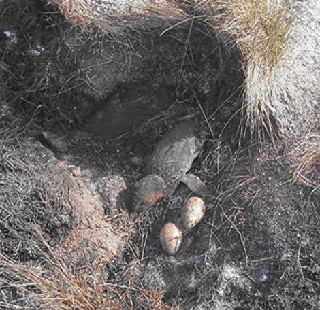
|
Published:
Global hotspot under stress
While the south-west corner of Western Australia is recognised as a global biodiversity hotspot, its unique ecosystems have suffered land clearing, introduced pests and weeds, a changed fire regime, loss of water and salinisation. Climate change may tip the balance for some species, unless effective action is taken, writes Andrew Burbidge.

|
|
The western swamp tortoise is one of more than 60 species of vertebrates endemic to south-west Australia. Credit: Bert & Babs Wells/DEC
|
The south-west of Western Australia, a flat, stable, highly-weathered low plateau dominated by old landscapes with nutrient-deficient soils, is the only designated global biodiversity hotspot in Australia.1 Of the 34 such areas worldwide, few are in developed countries.
There are more than 7400 named plant taxa and an estimated 6500 species of vascular flora in Australia’s south-west, of which more than 50 per cent occur nowhere else. Local species diversity and endemism is also high. For example, in the Fitzgerald River National Park (329 000 ha) there are 1883 plant taxa of which 72 occur only in the park, while Tutanning Nature Reserve (2000 ha) has 850 species.
Approximately 20 per cent of plant species in the south-west are listed as threatened, rare or poorly known; most threatened endemic taxa are woody species. Most plant species show very high levels of genetic diversity and population differentiation due to local persistence through geological time and natural fragmentation as a result of environmental heterogeneity.
Many taxa have very small geographic ranges. About 100 species of vertebrates are endemic, including the honey possum, quokka, red-capped parrot, western swamp tortoise and sunset frog. Some species that have become extinct elsewhere in Australia, such as the numbat, persist in the south-west. Many invertebrates occur nowhere else.
Sixty-three wetlands of national significance are located in the south-west region. In 2007, 82 threatened ecological communities, 351 threatened plant taxa (111 of which are critically endangered) and 69 threatened non-marine animal taxa (16 mammals, 19 birds, 11 reptiles, 3 frogs, 3 fish and 17 invertebrates) were in the south-west.
Near the south coast, many species and some ecosystems are restricted to hilltops. In the Stirling Range National Park, 20 threatened plant taxa, two threatened animal species and one threatened ecological community are found only at high elevations.
There are numerous Gondwanan relictual species in the south-west corner of the south-west, demonstrating the region’s role in harbouring organisms having an ancient genetic lineage. Almost all are dependent on mesic conditions.2 Many species of aquatic invertebrates are restricted to threatened ephemeral freshwater and brackish water ecosystems.

|
|
Kwongan heath in Fitzgerald River National Park, WA, a hotspot within a biodiversity hotspot, with 1883 vascular plant taxa occurring within the national park. Credit: Andrew Burbidge
|
Because it has a Mediterranean climate, fire is a major component of south-west ecosystems.
The south-west of Western Australia is the source of significant economic wealth, being Australia’s largest cereal cropping area and having major mineral deposits including bauxite, gold and manganese. Other land uses include timber harvesting and tourism.
The state’s capital, Perth, lies within the south-west region, and urban expansion and tourism are having a negative impact on coastal and near-coastal lands. Clearing for agricultural and urban use has been extensive. In one subregion, 93 per cent of land has been cleared.3
Small habitat remnants make conservation management difficult and limit species movement. Less than two per cent of this subregion is in protected areas. Salinisation is a major threat to both agricultural production and biodiversity conservation.
Catchment management, revegetation and new land use practices are increasingly important.

|
|
South-west Australia has the greatest diversity of banksias, with 60 of the 76 species – including Banksia hookerana, shown here – occurring there. Credit: Andrew Burbidge
|
In some areas it may become uneconomic to continue traditional farming practices, such as cereal cropping, due to reduced winter rainfall and increased costs. Further development of alternative crops, including those based on indigenous biodiversity, is needed. Some marginal land may be abandoned.
Many plants and ecosystems are threatened by the introduced water mould Phytophthora cinnamomi. Many animals are threatened by introduced predators. Environmental weeds are an increasing threat to ecosystems and species.
The opportunity to expand the protected area system from publicly-owned land is limited; expansion by protecting private land is a developing concept.
Numerous translocations of both plants and animals have been carried out in the south-west and, building on this experience, translocations to adapt to climate change will become important. The development of vegetation corridors linking the relatively well-vegetated higher rainfall south-west corner and south coast with inland semi-arid and arid lands has been proposed, and is under way (e.g. Gondwana Link, www.gondwanalink.org). Monitoring to evaluate the success of this strategy is vital.
The south-west has suffered a 10–20 per cent decrease in winter rainfall over the past 30 years together with temperature increases, especially in winter and autumn. This has resulted in sharp declines in both the quantity and quality of water flows.
The decline in precipitation was not gradual, but occurred quite abruptly in the mid-1970s. Groundwater-fed karst invertebrate communities, for example in the Yanchep Caves and on the Leeuwin-Naturaliste Ridge, are already under extreme threat from lowering groundwater.
|
When environments change rapidly, habitat or behavioural limitations will prevent many species from adapting. Recent observations suggest that Australia’s little penguins, for example, do not seem to know how to avoid fire, yet their environment is increasingly at risk of fire outbreaks. |
In coastal regions, misty rain or fog following long spells of hot, dry and dusty weather can result in the ignition of power-pole cross arms, due to a build-up of salt and dust on the insulators. The red-hot salt crust can fall from the pole and ignite vegetation at its base. |
In recent years a number of such fires have occurred on Phillip Island, Victoria, home to a large colony of little penguins, Eudyptula minor. These fires, as well as a lightning-initiated fire late in 2005 on Seal Island in Victoria, have caused the death or injury of many little penguins. |
In each case, the penguins did not avoid the fire, suggesting that their responses to fire are surprisingly inappropriate and maladaptive. |
In many cases, dead penguins were found either in their burrows (often collapsed) or within metres of burrows. Birds nesting under vegetation appeared to remain until they were severely burnt or killed. Penguins were also observed standing beside flames preening singed feathers, rather than moving away. |
Most live penguins suffered debilitating injuries including burns to their feet and legs, scorched feathers and blistered skin, swollen eyes, and many had difficulty breathing. |
The synchronised breeding of seabirds such as penguins when large numbers are present in a colony makes them particularly vulnerable to such fires during their nesting seasons. This is particularly true for burrow-nesting species, such as the little penguin, which are disinclined to abandon eggs or chicks, or emerge from their burrows during daytime. |
Increased occurrence of hot, dry and dusty weather is projected for the future and may result in increased fire-related risk of little penguin death and injury on Phillip Island if these periods are followed by rain or fog. |
As coastal development encroaches on little penguin colonies throughout south-eastern Australia, this risk is heightened. |
Risk reduction options include running the power underground, more regular pole inspections, improved insulator design and cleaning of the insulators. The risk of fire can be reduced further by appropriate habitat management such as the planting of fire-retardant vegetation and quick response by agencies when fires occur. |
1 In 1999, a group of researchers led by Norman Myers identified 25 global biodiversity hotspots comprising 1.4 per cent of the Earth’s land surface where as many as 44 per cent of all vascular plant species and 35 per cent of all species in four vertebrate groups are confined and considered threatened with destruction. The number of hotspots was later expanded to 34 (see www.biodiversityhotspots.org).
2 That is, having a moderate or well-balanced supply of water.
3 The Avon Wheatbelt 2 Interim Biogeographic Regionalisation for Australia (IBRA).




